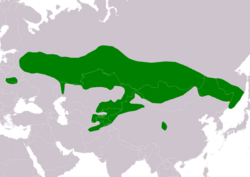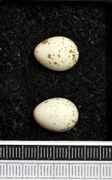Biology:Azure tit
| Azure tit | |
|---|---|

| |
| Scientific classification | |
| Domain: | Eukaryota |
| Kingdom: | Animalia |
| Phylum: | Chordata |
| Class: | Aves |
| Order: | Passeriformes |
| Family: | Paridae |
| Genus: | Cyanistes |
| Species: | C. cyanus
|
| Binomial name | |
| Cyanistes cyanus (Pallas, 1770)
| |

| |
| Azure tit distribution map Resident
| |
| Synonyms | |
|
Parus cyanus | |
The azure tit (Cyanistes cyanus) is a passerine bird in the tit family Paridae. It is a widespread and common resident breeder throughout Russia , Central Asia, northwest China, Manchuria, and Pakistan.
It is found in temperate and subarctic deciduous or mixed woodlands, scrub, and marshes. It is a resident species, and most birds do not migrate. It nests in tree holes, laying approximately 10 eggs. The bird is a close sitter, displaying defensive behaviors such as hissing and biting when disturbed. Its diet primarily consists of insects, seeds, small invertebrates, bug larvae, and eggs.
This 12–13 cm (4.7–5.1 in) bird is unmistakable. Its head, tail corners, wing bars, and underparts are white, while the upperparts are blue. It has a distinctive dark line running through its eye.
This bird is the eastern counterpart of the common Eurasian blue tit. It will hybridise with that species, but the offspring usually show a blue crown, rather than the white of azure tit. The calls are similar to blue tit, calling dee, dee, dee or a scolding churr. The song is a tsi-tsi-tshurr-tsi-tsi-tshurr, which has been described as intermediate between blue tit and crested tit.
There are some records of the species in other parts of Europe, including in Finland, Sweden, Poland and Austria.[2]
Taxonomy
For many years the azure tit was known as Parus cyanus. In 2005, analysis of the mtDNA cytochrome b sequences of the Paridae indicated that Cyanistes was an early offshoot from the lineage of other tits, and more accurately regarded as a genus rather than a subgenus of Parus.[3]
The azure tit not infrequently hybridizes with the blue tit in western Russia; the resulting birds are called Pleske's tit (Cyanistes × pleskei) and were once considered a distinct species.
The population in central Asia, yellow-breasted tit (C. c. flavipectus or Parus flavipectus), is sometimes included as a subspecies of the azure tit.[1][4]
Gallery
References
- ↑ 1.0 1.1 BirdLife International (2016). "Cyanistes cyanus". IUCN Red List of Threatened Species 2016: e.T22735985A87434883. doi:10.2305/IUCN.UK.2016-3.RLTS.T22735985A87434883.en. https://www.iucnredlist.org/species/22735985/87434883. Retrieved 12 November 2021.
- ↑ "Rare Western Palearctic birds: Azure Tit". 16 February 2007. https://www.birdguides.com/articles/western-palearctic/rare-western-palearctic-birds-azure-tit/.
- ↑ Gill, Frank B.; Beth Slikas and Frederick H. Sheldon (2005). "Phylogeny of titmice (Paridae): II. Species relationships based on sequences of the mitochondrial cytochrome-b gene". Auk 122 (1): 121–143. doi:10.1642/0004-8038(2005)122[0121:POTPIS2.0.CO;2].
- ↑ "Cyanistes flavipectus". Avibase. https://avibase.bsc-eoc.org/species.jsp?lang=EN&avibaseid=B9BE501675DAC3CA.
- Harrap, Simon & Quinn, David (1996): Tits, Nuthatches & Treecreepers. Christopher Helm, London. ISBN:0-7136-3964-4
Wikidata ☰ Q499283 entry
 |





